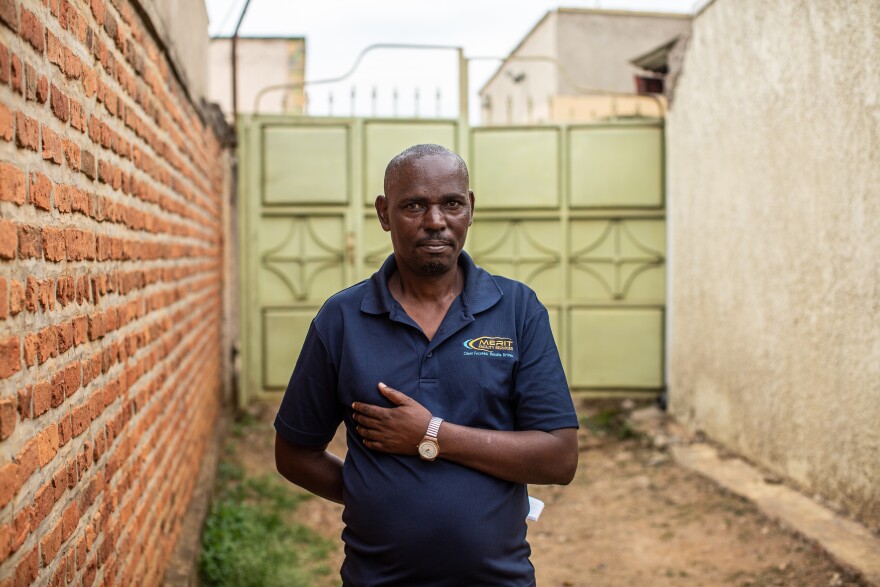NYAMATA, Rwanda — Rachel Mukantabana was a teenager when the devastating genocide in Rwanda unfolded.
"I was 15 years old and I knew exactly what was happening," she told NPR. "Even a five-year-old knew what was about to happen."
Two days into the 100-day genocide, Mukantabana and her family fled their homes. They first went to a church, and then a school, before ultimately hiding in a large swamp — hoping that no one would be able to reach them in the water.
This week, Rwanda marks the 30th anniversary of the genocide in which nearly one million people, most of them ethnic Tutsis, were killed.
As many as a quarter million Rwandan civilians participated in the killings. Across the country, neighbors brutally attacked their neighbors with machetes, sticks and clubs.
The violence was intimate and vicious.
In those first days in the swamp in 1994, Mukantabana and her family were safe. But near the end of April, she said, hundreds of soldiers and Interahamwe — Hutu militia members — came.
"They surrounded the whole swamp and killed people until the evening," she said.
They returned the next day, in even greater numbers, to kill again. Mukantabana's younger sister was killed with a spear, and Mukantabana was captured.
She begged for her life, trying to convince the soldiers that her father was a Hutu man.
"They were checking my legs and said, 'Your legs look like a Tutsis','" she said.
The soldiers beat her legs with a hammer, but she was able to get away and hide in the swamp again. She hid there for weeks with others, she said, as a brutal pattern played out.

"The way we knew that the killing had stopped was, they'd shoot one bullet in the air," she said. "That meant the killing was over for the day. They'll be back tomorrow."
In May, a group of rebel soldiers led them out of the swamp.
Mukantabana said that her mother, four siblings and more than 50 members of her extended family were killed during the genocide.
Today, Mukantabana lives in a "reconciliation village," where people who survived the genocide live side by side with the very perpetrators who killed.
Measuring reconciliation
Forgiveness and reconciliation are personal. But in Rwanda today, they are also orchestrated by the government.
The Rwandan government, led by President Paul Kagame, has outlawed speech that draws distinctions between ethnic groups. National ID cards no longer identify ethnic groups. Laws ban so-called genocidal ideology.
The government has an official "reconciliation barometer," which looks at a variety of factors to determine how people are living together. In 2020 — the last year for which data is available — the country deemed reconciliation in Rwanda to be at 94.7%.
"Rwandans generally revere the government. So I definitely think that the state is highly involved and in some ways it's hard to disentangle anything from such a powerful government," said Hollie Nyseth Nzitatira, an associate sociology professor at Ohio State University, whose research focuses on why genocide happens and how countries rebuild.
She has conducted extensive interviews with genocide survivors and perpetrators.
"I do think that reconciliation is happening in Rwanda, but most of the folks that I spoke with wouldn't say it's been achieved, but rather it's a messy process," she said.
Nyseth Nzitatira said that what happened in Rwanda could be instructive for other countries.
"What many countries could learn from Rwanda is the value of explicitly addressing your past, of talking about what happened, of coming to terms with what happened, of commemorating what happened," she said. "And this is something that Rwanda has done incredibly well."
At the reconciliation village, we tell Mukantabana that we plan to meet with genocide perpetrators too, including a man who lives a short drive from her. And we ask her what kind of questions she thinks we should ask him.
"What I would ask them is, when they were killing people, inside themselves, did they feel human or [like] animals?"

We put this question to Didas Kayinamura when we met him at his home a short time later.
Speaking through an interpreter, he said that he was coerced by a killing group, and that they threatened his life. They pushed him, he said, to kill a man.
"They gave me a stick, a very strong stick, and they said, you have to kill him with this stick," he said.
Kayinamura said that he tried to kill the man twice, but ultimately, someone else delivered the killing blow.
He said that despite pressure, he never participated in the violence again.
"One guy. That's it. I stopped. I killed once," he said.
Two identities
First person narratives about genocide are complex. Experts say there can be a tendency among perpetrators to minimize their role — sometimes in the hope of a shorter prison sentence, sometimes because the trauma of the genocide alters a perpetrator's memory.
"I'm not saying I'm not a killer. I'm not saying I didn't participate in a genocide," Kayinamura said. "I committed genocide. Why? Because when this group of people went to kill this gentleman, I went with them."
Perpetrators like Kayinamura were tried in community-based courts that sprung up quickly. The accused were judged by their neighbors. The proceedings relied on eyewitness narratives of fast-moving, violent incidents.
These Gacaca courts tried criminals, but also promoted interpersonal forgiveness and reconciliation.
"The first thing they said in Gacaca court was to say if someone ... asks for forgiveness ... he will get out of prison," Kayinamura said. He ended up serving more than six years in prison.
"My identity is genocidaire," he said, evoking a word for someone who participated in a genocide.
Mukantabana has a different identity: mother. She is raising five children and sees a clear future for herself.
"For me, the fact that I have children gives me the confidence to rebuild my life," she said. "My children have allowed me to start over."

Mukantabana's new life includes learning how to live in a community with people who 30 years ago could have wanted her dead.
When asked if she feels comfortable living in the reconciliation village, she gestured just outside the door. The man walking outside, she said, is a Hutu. And she doesn't feel afraid.
"Thirty years after genocide ... things are pretty good," Mukantabana said. "People live together peacefully. There's no more Hutu, no more Tutsi — we are all Rwandan."
All Rwandan, all now living under the shadow of a brutal history that pitted neighbor against neighbor.
The people who served the longest sentences for their roles in the genocide are just returning home, and the work of learning to live side-by-side continues.
Copyright 2024 NPR. To see more, visit https://www.npr.org.





